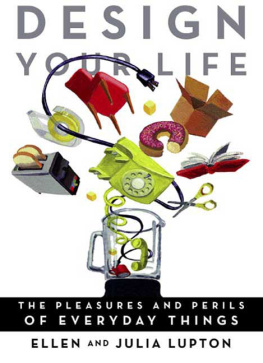I found myself in a narrow room. Two vinyl-covered armchairs faced the foot of my bed; a small steel table on wheels was stationed in a far corner. Was it a minimum security prison for inside traders? No, it was the hospital room where I was sent to rest after delivering my second baby. Holding my newborn daughter against my chest and grateful for the basic comforts of this ordinary room, I didnt give a second thought to how it was designed.
My husband Abbott, however, paced around the room, seeing flaws in its arrangement and seeking ways to improve it. He brings this creative and critical eye everywhere he goes. At his sisters house one holiday, he reshuffled the light bulbs in the living room, changing the wattage in each lamp to make the setting more sociablebrighter here, dimmer there. Invited to lecture at a university, he realigned a rigid battalion of chairs into relaxed, staggered waves.
Here in this hospital room, our son would meet his baby sister for the first time, and my parents would hold their newest granddaughter. The poorly sited armchairs would have placed our guests at the end of my weary body, so Abbott moved them near the window and alongside the bed. He commandeered an extra chair from the hallway and added it to this newly assembled seating area. The steel table migrated there as well, providing a resting spot for cups of coffee and cans of Coke as well as a vase of flowers.
As I cradled our sleeping daughter in my arms, I watched an indifferently planned space become a room that welcomed visitors and encouraged lingering and conversation.
Ten years later, the kids and I have learned a lot from Abbotts penchant for moving furniture. Although we are sometimes mystified by his constant attention to how things are arranged, in the end, he nearly always succeeds in making the spaces we live in brighter, or more comfortable, or simply refreshed and renewed. Change, in itself, keeps our rooms alive.
Daddy is a poltergeist, I say to our kids, explaining how massive pieces of furniture have managed to move from room to room while we were out playing at the park.
Daddy has a furniture problem, I declare, as Abbott enters the house one Sunday heaving along two vintage Florence Knoll end tables and a George Nelson desk purchased from a local antique dealer.
They had just arrived in the store when I got there, he exclaims, glowing with exertion and delight.
How much?
Not cheap.
Where will they go?
Ill find a place.
A clunky ballet ensues as tables, chairs, and sofas seek alternate lodging throughout the house, where they enjoy new lives in new locations. Many people avoid moving furniture, putting in place their couch, chairs, coffee table, and lamps, and leaving them there for years, even a lifetime. The furniture melts into the floor and becomes invisible. My maternal grandmother lived in several different homes when I was growing up, and she managed to arrange the furniture the same way wherever she went. It was as if she hadnt moved at all.
In the Middle Ages and Renaissance, domestic spaces were reconfigured daily, with one large room accommodating work, meals, and sleep. The French word for furniture is meubles, meaning moveable; Spanish is muebles, Italian is mobili, and Portuguese is mobilirio. Chairs are the ultimate moveable furnishings, easily reconfigured to create circles of conversation or rows of attention. Portable folding chairs date from antiquity.
In our era of more frozen floor plans, rezoning often occurs as families expand and contractadding new members, adapting to changing abilities and disabilities, expelling grown children and absorbing aging parents. But furniture neednt wait for major life changes in order to be moved. When we recently shifted a marble coffee table from one sitting area to another, we discovered that the piece reflects more light in its new setting, subtly changing the entire room.
People who never move their furniture stop seeing their environment. They get used to banging into an awkwardly placed bureau, bruising their shins on it over and over without deciding to shift its position. They avoid sitting in an uncomfortable chair, but dont replace it, and they stop using a drawer that sticks, but dont fix it. A vase or curio waits unnoticed in its cabinet, and works of art fade away into the paint and plaster.
A few years ago, our Baltimore town house became a location for a Hollywood film. Over the course of a week, we saw our rooms transformed not just once but several times. The set decorator, a big bossy blonde from Los Angeles, borrowed chairs, tables, sofas, and beds from furniture stores around the city; most pieces were sent back in failure as she searched for just the right look. As the rooms continued to convulse with furniture, a pattern emerged: although the pieces kept changing, their position stayed more or less the same. A bigger couch superseded a smaller one. A puffy chair with stubby legs supplanted a square one dressed in a box-pleated skirt. Whats more, the arrangement of these new pieces duplicated that of our own furnishings. A new dining area appeared exactly where ours had been, with artfully mismatched antiques replacing our modern table and chairs.
The team from Hollywood hadnt redesigned our house; they had merely switched out the objects and finishes. The sight lines, traffic patterns, and basic functions had stayed the same. Changing a slipcover to match the drapes isnt design in the most active sense.
Design is thinking, materialized in objects and environments, inscribed in patterns of use, and addressed by analysis and planning. A work of designbe it a room, a jacket, or a pageresults from deliberate thought. What is it for? What will it cost? How will it be used? Well-designed environments make sense, their beauty often resting in the transparency and accessibility of their functions. Design sometimes means exposing an environments hidden agenda and making the most of it. If your dining room has become a place where books and papers are stacked, perhaps its time to turn it into a library. If everyone in the house gravitates to the most comfortable chair, you may want to find other chairs like it. When people allow the functions of a room to ossify, they ignore the power of design.
Do you control your environment, or does your environment control you? Moving the furniture is part of the philosophy of this book. The people in your world can become furniture, too, used but not noticed, made invisible through habit. Your calendar of routines and obligations is a floor plan for the day; make sure that each room is serving your needs and pleasures as best it can. At our house, moving the furniture has become a way of pulling happiness and sociabilityin place of frustration and boredomout of ordinary situations, simply by shaking them up a bit. EL
PERSISTENCE OF THE LIVING ROOM Typical suburban floor plan










